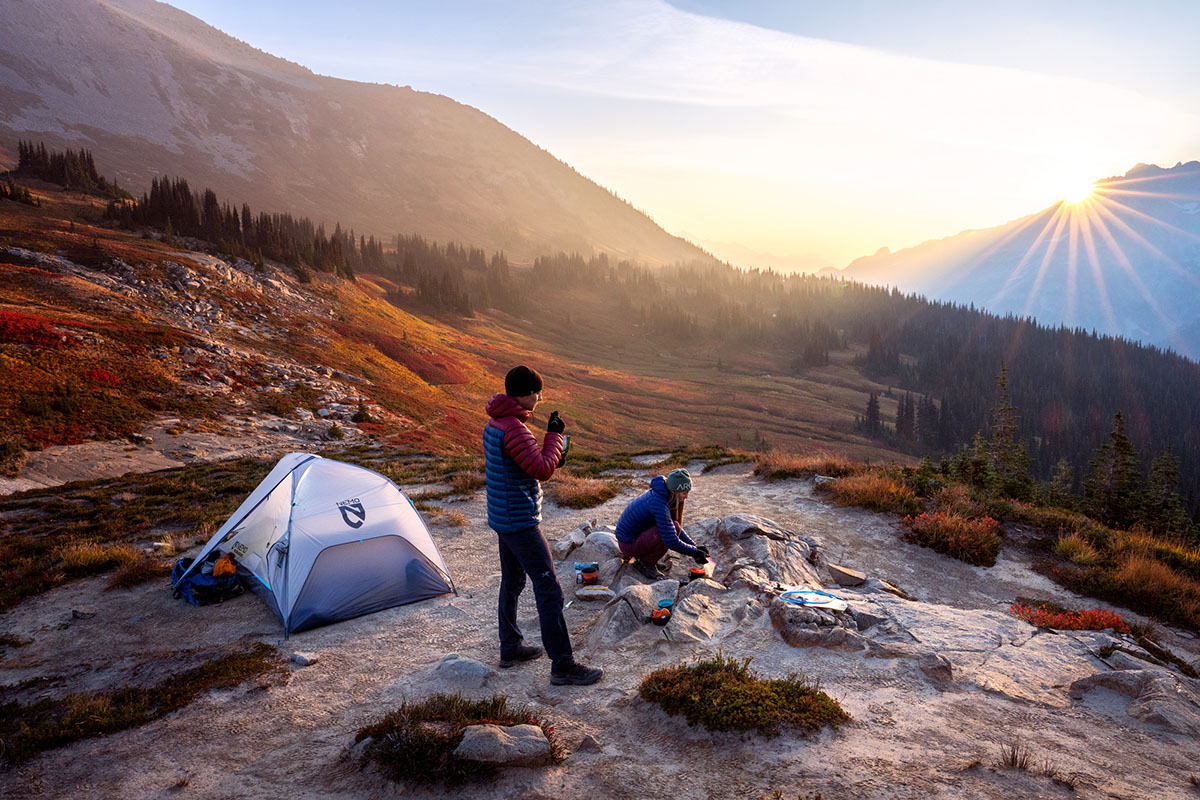
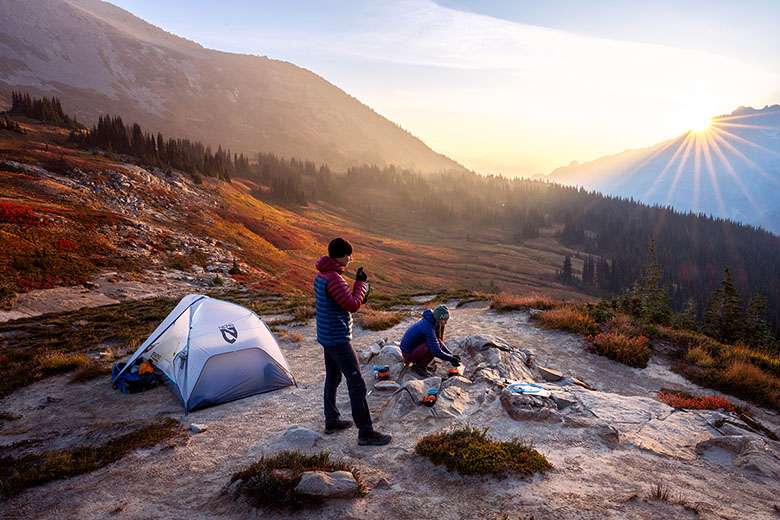
If you’re researching backpacking tent weight, you’ve come to the right place. Below, we’ve put together detailed tent weight comparison tables covering most models available for the summer of 2025. For comparison's sake, all are two-person, three-season tents (many have solo and family versions available as well), and we've listed the full packaged weight. The first table includes traditional backpacking tents with poles, and the bottom table has trekking pole-supported shelters that do not come with poles, many of which are single-wall designs. For the latter, you’ll have to add in the weight of your trekking pole(s) for an accurate total. We’ve also included some key buying considerations below the tables. For a wider and more in-depth look at the market, see our articles on the best backpacking tents and best ultralight tents.
Editor’s note: We updated this article on July 17, 2025, to update prices, weights, and all other info on our lists of backpacking tents and trekking pole-supported shelters. We also updated any pertinent info in the buying advice below the tables to ensure accurate and up-to-date information.
| Tent | Weight | Price | Packed Size | Floor Area | Doors |
|---|---|---|---|---|---|
| Big Agnes Fly Creek HV 2 Carbon | 1 lb. 7.0 oz. | $1,600 | 18.5 x 5.0 in. | 28.0 sq. ft. | 1 |
| Nemo Hornet Elite Osmo 2P | 1 lb. 13 oz. | $660 | 19.0 x 4.0 in. | 21.8 sq. ft. | 2 |
| Tarptent Double Rainbow Li | 1 lb. 14.6 oz. | $799 | 17.0 x 4.5 in. | 30.6 sq. ft. | 2 |
| Zpacks Free Zip 2P | 1 lb. 15.6 oz. | $899 | 12.0 x 6.0 in. | 26.3 sq. ft. | 2 |
| Big Agnes Tiger Wall 2 Platinum | 2 lb. 3.0 oz. | $650 | 18.0 x 5.0 in. | 28.0 sq. ft. | 2 |
| Big Agnes Fly Creek UL 2 | 2 lb. 4.0 oz. | $400 | 19.5 x 6.0 in. | 28.0 sq. ft. | 1 |
| Mountain Hardwear Nimbus UL 2 | 2 lb. 4.6 oz. | $420 | 12.0 x 6.0 in. | 28.1 sq. ft. | 1 |
| MSR FreeLite 2 | 2 lb. 5.0 oz. | $465 | 18.0 x 4.5 in. | 29.0 sq. ft. | 2 |
| Tarptent Double Rainbow | 2 lb. 7.0 oz. | $349 | 18.0 x 4.5 in. | 30.6 sq. ft. | 2 |
| Big Agnes Tiger Wall UL2 | 2 lb. 8.0 oz. | $480 | 18.0 x 5.5 in. | 28.0 sq. ft. | 2 |
| Nemo Hornet Osmo 2P | 2 lb. 8.0 oz. | $450 | 12.5 x 7.5 in. | 27.5 sq. ft. | 2 |
| Mountain Hardwear Strato UL 2 | 2 lb. 8.7 oz. | $480 | 12.0 x 6.0 in. | 31.1 sq. ft. | 2 |
| Big Agnes Fly Creek HV UL2 Bikepack | 2 lb. 10.0 oz. | $450 | 14.0 x 6.5 in. | 28.0 sq. ft. | 1 |
| Big Agnes Copper Spur 2 Platinum | 2 lb. 10.0 oz. | $600 | 17.0 x 5.0 in. | 29.0 sq. ft. | 2 |
| Tarptent Double Rainbow DW Ultra | 2 lb. 11.0 oz. | $539 | 18.0 x 5.0 in. | 30.6 sq. ft. | 2 |
| Tarptent Double Rainbow DW | 2 lb. 12.6 oz. | $389 | 18.0 x 4.5 in. | 30.6 sq. ft. | 2 |
| SlingFin 2Lite | 2 lb. 14.2 oz. | $505 | 13.0 x 5.0 in. | 28.5 sq. ft. | 2 |
| Big Agnes Tiger Wall UL2 Bikepack | 2 lb. 15.0 oz. | $500 | 13.0 x 6.5 in. | 28.0 sq. ft. | 2 |
| Sea to Summit Alto TR2 | 2 lb. 15.3 oz. | $410 | 20.5 x 4.7 in. | 27.0 sq. ft. | 2 |
| Big Agnes Copper Spur UL2 | 3 lb. 2.0 oz. | $550 | 19.5 x 6.0 in. | 29.0 sq. ft. | 2 |
| Nemo Dragonfly Osmo 2P | 3 lb. 2.0 oz. | $500 | 19.5 x 5.5 in. | 29.0 sq. ft. | 2 |
| Big Agnes Copper Spur HV UL2 mtnGLO | 3 lb. 3.0 oz. | $600 | 20.0 x 6.0 in. | 29.0 sq. ft. | 2 |
| Sea to Summit Alto TR2 Plus | 3 lb. 3.4 oz. | $449 | 21.0 x 5.0 in. | 27.0 sq. ft. | 2 |
| Big Agnes Copper Spur UL2 XL | 3 lb. 5.0 oz. | $580 | 22.0 x 6.0 in. | 31.0 sq. ft. | 2 |
| MSR Hubba Hubba LT 2 | 3 lb. 6.0 oz. | $550 | 20.0 x 5.5 in. | 32.0 sq. ft. | 2 |
| Mountain Hardwear Aspect 2 | 3 lb. 5.0 oz. | $530 | 20.5 x 6.0 in. | 29.3 sq. ft. | 2 |
| SlingFin Portal 2 | 3 lb. 5.0 oz. | $560 | 14.0 x 5.0 in. | 27.5 sq. ft. | 2 |
| Sea to Summit Telos Bikepacking TR2 | 3 lb. 5.2 oz. | $524 | 11.8 x 8.7 in. | 28.0 sq. ft. | 2 |
| Big Agnes Copper Spur HV UL2 Bikepack | 3 lb. 8.0 oz. | $580 | 13.5 x 7.0 in. | 29.0 sq. ft. | 2 |
| Nemo Mayfly Osmo 2P | 3 lb. 8.0 oz. | $450 | 19.5 x 6.5 in. | 27.9 sq. ft. | 2 |
| Sea to Summit Telos TR2 Plus | 3 lb. 9.7 oz. | $485 | 19.0 x 6.0 in. | 28.0 sq. ft. | 2 |
| Sea to Summit Telos TR2 | 3 lb. 10.7 oz. | $449 | 19.0 x 5.0 in. | 28.0 sq. ft. | 2 |
| Hilleberg Niak | 3 lb. 12.0 oz. | $990 | 18.0 x 6.0 in. | 28.0 sq. ft. | 1 |
| MSR Hubba Hubba Bikepack 2P | 3 lb. 12.0 oz. | $580 | 14.5 x 7.0 in. | 29 sq. ft. | 2 |
| Nemo Dragonfly Bikepack Osmo 2P | 3 lb. 13.0 oz. | $580 | 14.5 x 6.5 in. | 29.0 sq. ft. | 2 |
| Nemo Dagger Osmo 2P | 3 lb. 15.0 oz. | $550 | 20.0 x 6.5 in. | 30.6 sq. ft. | 2 |
| Big Agnes C Bar 2 | 4 lb. 0 oz. | $250 | 19.0 x 6.0 in. | 28.0 sq. ft. | 1 |
| Hilleberg Anjan 2 | 4 lb. 0 oz. | $895 | 19.0 x 4.0 in. | 28.0 sq. ft. | 1 |
| Big Agnes Salt Creek SL2 | 4 lb. 1.0 oz. | $350 | 20.5 x 6.5 in. | 28.0 sq. ft. | 3 |
| Alps Mountaineering Helix 2P | 4 lb. 2.0 oz. | $250 | 18.0 x 6.0 in. | 31.5 sq. ft. | 2 |
| Big Agnes Crag Lake 2 | 4 lb. 4.0 oz. | $350 | 18.5 x 6.0 in. | 28.0 sq. ft. | 2 |
| Hilleberg Anjan 2 GT | 4 lb. 10.0 oz. | $1065 | 19.0 x 6.0 in. | 28.0 sq. ft. | 1 |
| Kelty Grand Mesa 2 | 4 lb. 12.0 oz. | $150 | 16.0 x 7.0 in. | 30.0 sq. ft. | 1 |
| Kelty Ashcroft 2 | 4 lb. 14.0 oz. | $120 | 18.5 x 5.5 in. | 32.6 sq. ft. | 1 |
| Kelty Discovery Trail 2 | 4 lb. 14.0 oz. | $120 | 19.0 x 6.0 in. | 32.6 sq. ft. | 1 |
| Big Agnes Blacktail 2 | 5 lb. 8.0 oz. | $250 | 21.0 x 7.0 in. | 33.0 sq. ft. | 2 |
| The North Face Trail Lite 2 | 5 lb. 1.5 oz. | $325 | 19.0 x 8.0 in. | 31.5 sq. ft. | 2 |
| Mountainsmith Bear Creek 2 | 5 lb. 3.0 oz. | $150 | 17.0 x 7.0 in. | 30.5 sq. ft. | 1 |
| Sea to Summit Ikos TR2 | 5 lb. 3.6 oz. | $335 | 20.0 x 7.0 in. | 31.2 sq. ft. | 2 |
| Marmot Tungsten 2P | 5 lb. 4.7 oz. | $249 | 24.4 x 5.9 in. | 30.1 sq. ft. | 2 |
| Eureka Tetragon NX 2 | 5 lb. 4.8 oz. | $116 | 24.0 x 5.0 in. | 35.0 sq. ft. | 1 |
| Alps Mountaineering Mystique 2P | 5 lb. 6.0 oz. | $150 | 20.0 x 6.5 in. | 32.0 sq. ft. | 2 |
| Kelty Far Out 2 | 5 lb. 7.0 oz. | $200 | 16.5 x 6.0 in. | 27.9 sq. ft. | 2 |
| REI Co-op Trailmade 2 | 5 lb. 7.0 oz. | $199 | 18.0 x 8.0 in. | 31.8 sq. ft. | 2 |
| Nemo Aurora 2P | 5 lb. 10.0 oz. | $300 | 21.5 x 8.0 in. | 32.4 sq. ft. | 2 |
| Alps Mountaineering Zephyr 2P | 5 lb. 11.0 oz. | $170 | 18.0 x 6.0 in. | 31.0 sq. ft. | 2 |
| Alps Mountaineering Lynx 2P | 5 lb. 12.0 oz. | $160 | 21.0 x 6.0 in. | 37.0 sq. ft. | 2 |
| Alps Mountaineering Felis 2P | 5 lb. 12.0 oz. | $200 | 13.0 x 6.5 in. | 37.0 sq. ft. | 2 |
| The North Face Stormbreak 2 | 5 lb. 14.2 oz. | $200 | 22.0 x 7.0 in. | 30.6 sq. ft. | 2 |
| Marmot Limelight 2P | 5 lb. 14.5 oz. | $299 | 24.4 x 5.5 in. | 34.4 sq. ft. | 2 |
| REI Co-op Trail Hut 2 | 5 lb. 15.0 oz. | $229 | 18.0 x 8.0 in. | 31.7 sq. ft. | 2 |
| REI Co-op Half Dome 2 | 5 lb. 15.1 oz. | $299 | 22.0 x 7.3 in. | 31.8 sq. ft. | 2 |
| Coleman Peak1 2P | 6 lb. 1.0 oz. | $320 | 24.0 x 6.0 in. | 31.7 sq. ft. | 2 |
| Eureka Summer Pass 2 | 6 lb. 1.6 oz. | $250 | 20.0 x 6.0 in. | 29.3 sq. ft. | 2 |
| Big Agnes Blacktail Hotel 2 | 6 lb. 2.0 oz. | $300 | 21.0 x 7.0 in. | 33.0 sq. ft. | 2 |
| MSR Elixir 2 | 6 lb. 3 oz. | $320 | 20.0 x 6.5 in. | 29.0 sq. ft. | 2 |
| Kelty Tanglewood 2 | 6 lb. 7.0 oz. | $90 | 18.0 x 8.0 in. | 29.4 sq. ft. | 1 |
| Marmot Vapor 2 | 6 lb. 7.5 oz. | $289 | 22.0 x 6.7 in. | 31.2 sq. ft. | 2 |
| Mountain Hardwear Mineral King 2 | 6 lb. 8.0 oz. | $325 | 24.0 x 6.0 in. | 33.0 sq. ft. | 2 |
| Alps Mountaineering Chaos 2 | 6 lb. 8.0 oz. | $200 | 20.0 x 6.5 in. | 33.0 sq. ft. | 2 |
| Tent | Weight | Price | Packed Size | Floor Area | Doors |
|---|---|---|---|---|---|
| Zpacks Duplex | 1 lb. 1.9 oz. | $699 | 12.0 x 6.0 in. | 28.1 sq. ft. | 2 |
| Zpacks Offset Duo | 1 lb. 3.4 oz. | $799 | 12.0 x 6.0 in. | 31.4 sq. ft. | 2 |
| Zpacks Duplex Zip | 1 lb. 3.6 oz. | $729 | 12.0 x 6.0 in. | 28.1 sq. ft. | 2 |
| Durston X-Mid Pro 2 w/ DCF floor | 1 lb. 5.0 oz. | $749 | 11.0 x 5.0 in. | 28.8 sq. ft. | 2 |
| Hyperlite Unbound 2P | 1 lb. 6 oz. | $699 | 8.5 x 5.5 in. | 28.0 sq. ft. | 2 |
| Black Diamond Beta Light 2P | 1 lb. 7.0 oz. | $350 | 16.0 x 11.0 in. | 54.0 sq. ft. | 2 |
| Durston X-Mid Pro 2 w/ woven floor | 1 lb. 7.1 oz. | $649 | 11.0 x 5.0 in. | 28.8 sq. ft. | 2 |
| Gossamer Gear The Two | 1 lb. 11.9 oz. | $320 | 11.0 x 5.0 in. | 29.0 sq. ft. | 2 |
| Mountain Laurel Duomid w/ InnerNet | 1 lb. 15.0 oz. | $585 | Unavailable | 51.9 sq. ft. | 1 |
| Durston X-Mid 2 | 1 lb. 15.0 oz. | $289 | 12.0 x 6.0 in. | 33.2 sq. ft. | 2 |
| Six Moon Designs Owyhee | 1 lb. 15.2 oz. | $310 | 12.0 x 4.5 in. | 53.0 sq. ft. | 2 |
| Tarptent StratoSpire Li | 2 lb. 0.5 oz. | $819 | 16.0 x 5.0 in. | 26.9 sq. ft. | 2 |
| Six Moon Designs Haven | 2 lb. 2.0 oz. | $375 | Unavailable | 27.0 sq. ft. | 2 |
| LightHeart Gear Duo | 2 lb. 4.0 oz. | $340 | Unavailable | 38.2 sq. ft. | 2 |
| Tarptent StratoSpire Ultra | 2 lb. 7.7 oz. | $519 | 16.0 x 6.0 in. | 32.8 sq. ft. | 2 |
| Hyperlite Ultamid 2 w/ Mesh Insert | 2 lb. 9.1 oz. | $1,098 | Unavailable | 63.0 sq. ft. | 1 |
| Tarptent StratoSpire 2 | 2 lb. 11.8 oz. | $389 | 16.0 x 5.0 in. | 31.1 sq. ft. | 2 |
| Six Moon Designs Lunar Duo | 2 lb. 13.0 oz. | $395 | 15.0 x 6.0 in. | 34.0 sq. ft. | 2 |
| REI Co-op Flash Air 2 | 2 lb. 13.7 oz. | $389 | 17.9 x 16.9 in. | 28.7 sq. ft. | 2 |
The weights that we have listed in the tables above are the packaged weight (our cutoff was 6.5 lb., but most backpackers aim to keep things lighter). This includes everything from the manufacturer: the tent body, rainfly, poles, stakes, guylines, repair sleeve, and tent and stake bags. Another popular spec to list is trail weight, which includes only the tent body, rainfly, and poles, and as a result, winds up about 5 to 7 ounces lighter. Trail weight (also referred to as minimum weight) leaves out the stakes, so it's not an exact representation of what you will be hauling.
That said, packed weight doesn’t entirely reflect what everyone will be taking on the trail. Some manufacturers include extra guylines, which you may want to leave behind, and we often ditch the tent pole bag and just strap the poles to the outside of our pack. We still recommend estimating your load to include packed weight to be safe, but trimming a few ounces off that spec is realistic. Finally, keep in mind that most packaged weights don’t include a footprint. If you value the added floor protection, estimate on another 5 to 10 ounces.
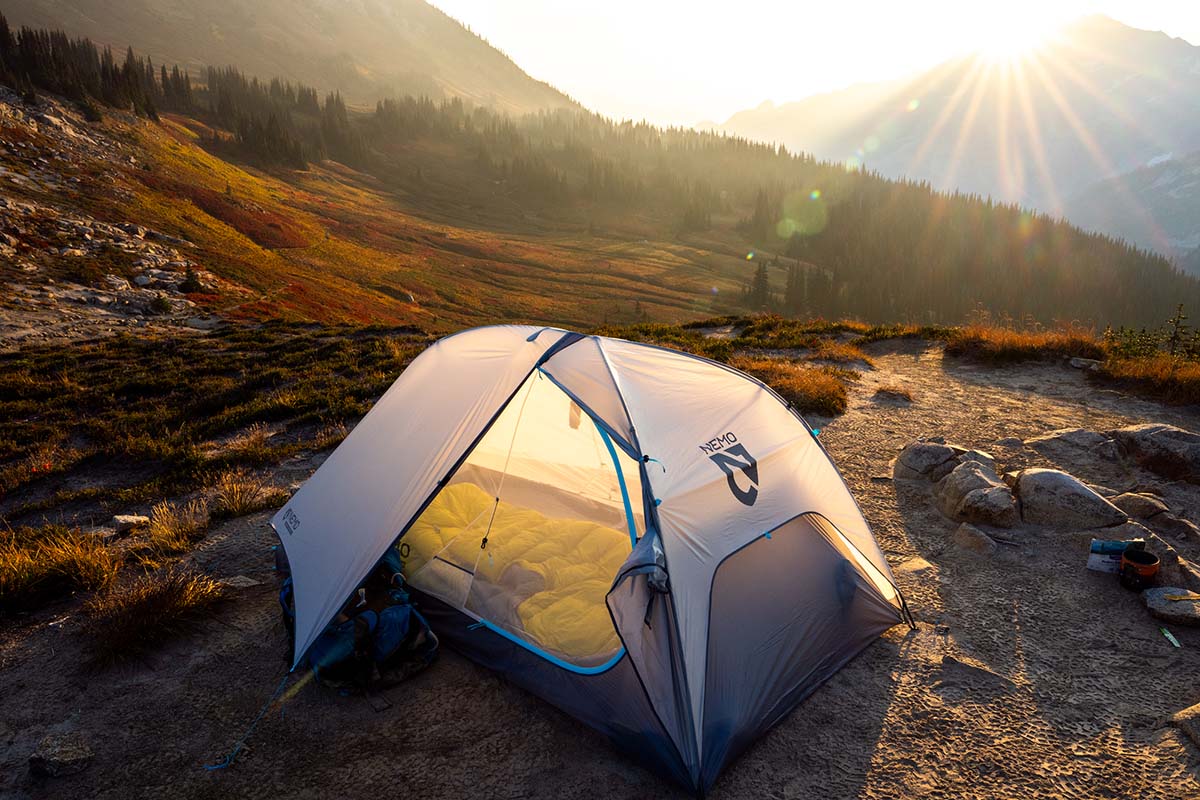
On paper, choosing an ultralight tent is a good proposition. They cost more, but you trim precious pounds from the weight on your back. We’re right there with you, but the compromises that come with reducing weight can make some backpackers reconsider.
Manufacturers cut weight first by using thinner fabrics and materials, then by reducing interior space. We cover interior space below, so we’ll focus on tent construction here. In comparing tents with similar dimensions but different weights, the lighter tent will have thinner fabrics, lighter tent poles, and smaller zippers. Durability can suffer as a result, and backpackers who are hard on their gear or aren’t familiar with tent care can damage these expensive products.
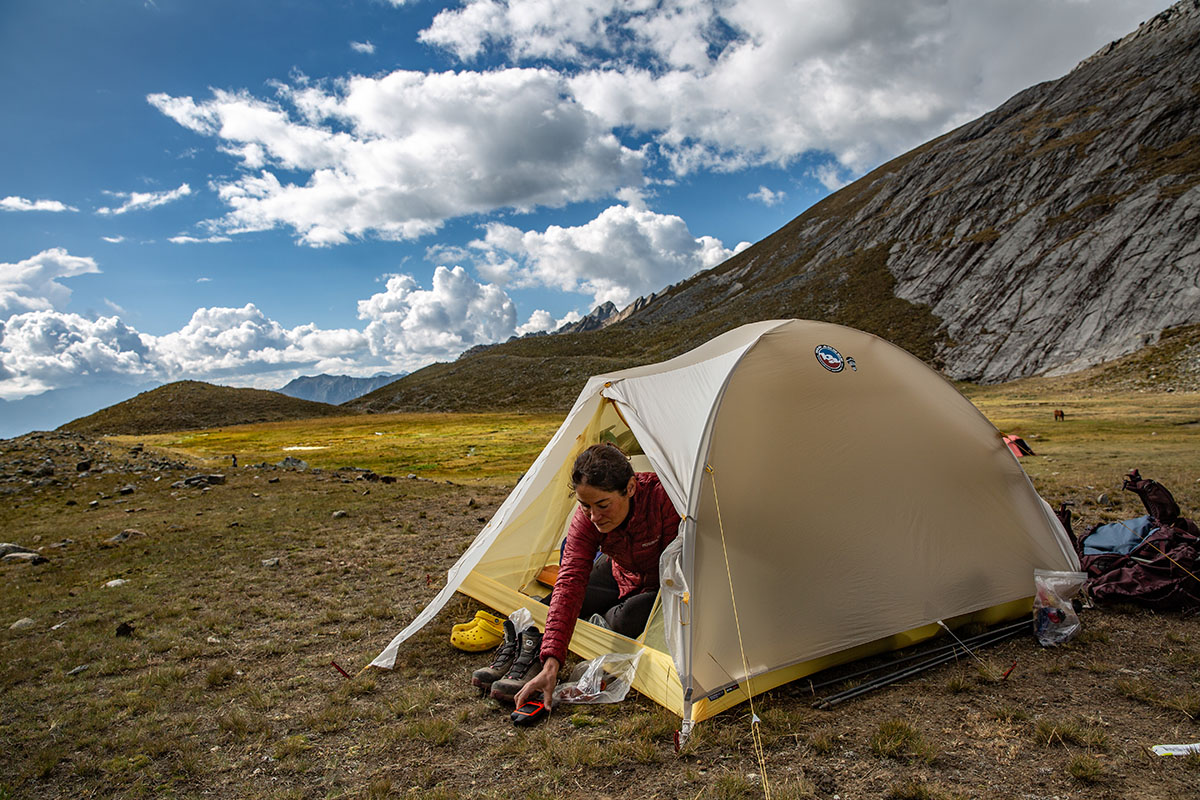
Nearly all manufacturers list the denier (D) of their floors, tent walls, and rainfly, and the lower the number, the thinner the fabric. Ultralight tents like the Big Agnes Tiger Wall UL2 use a 15D fabric on the floor and rainfly, which pushes the limits of practicality. On the other hand, it’s absolutely awesome for thru-hikers and minimalists willing to treat it like a newborn—you get a completely bug-proof and weather-worthy tent for 2 pounds 8 ounces. The durability trade-offs and extra cost are what push people to popular tents like the MSR Hubba Hubba, which uses a more durable 20D floor but weighs nearly a pound more.
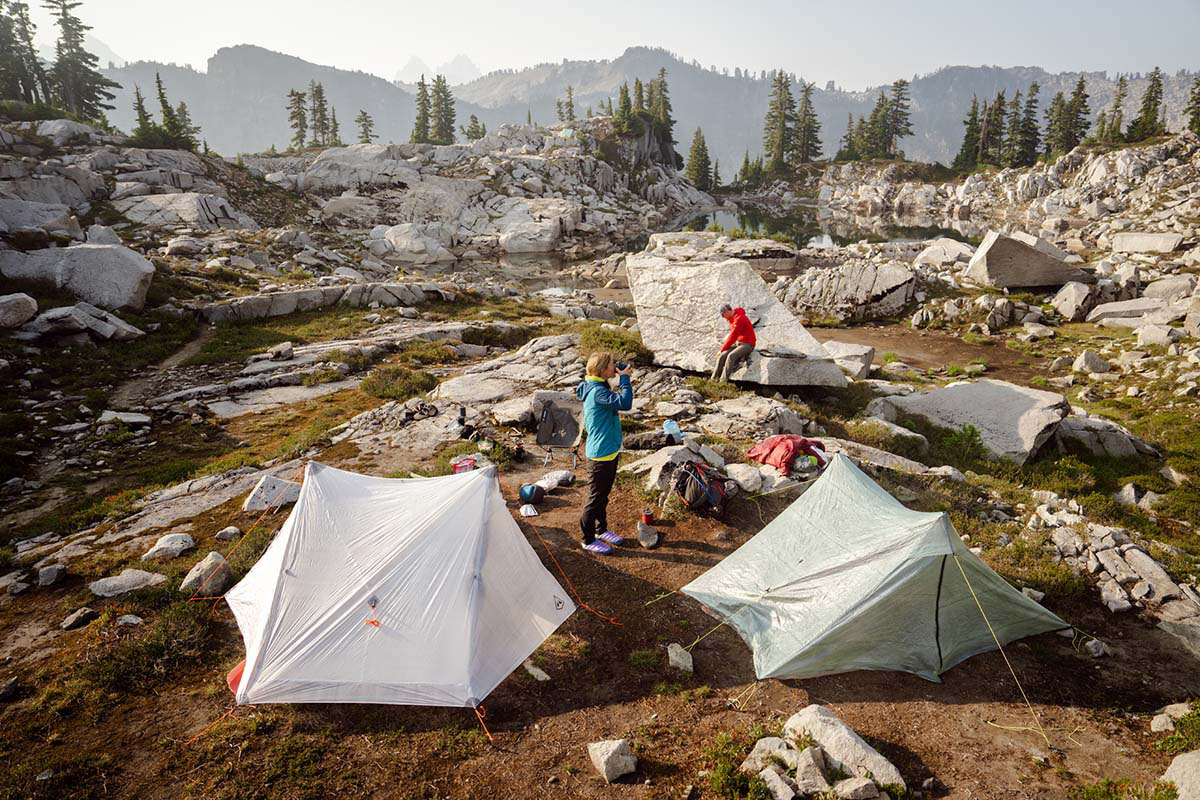
From a quick look at the tables above, it’s obvious that packed size almost always correlates with weight. The lighter the tent, the smaller the packed size. And while the actual dimensions are helpful, it doesn’t mean that you need to find space inside or outside your pack to fit a 21 x 6-inch tent burrito. We usually separate the tent poles from the tent body to better distribute weight among group members and minimize excess bulk. The best use of the packed size specification is to get a general idea of how bulky the gear is for planning out the rest of your kit, like the ideal capacity and style of your backpacking pack.
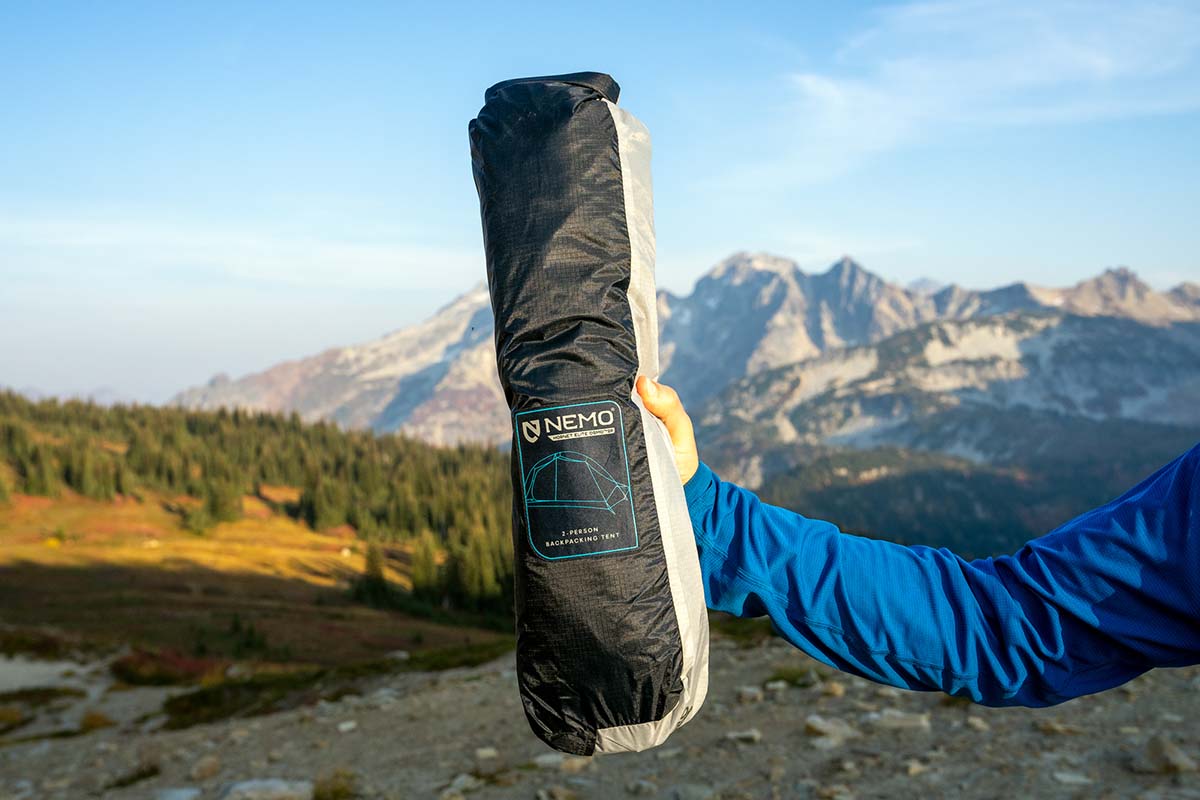
Unfortunately, interior space is one of the first things to go when trimming tent weight. We like the floor area spec (measuring length by width) as a comparative measure, but it does come with a caveat: This measurement is taken right at ground level and does not account for the livable space above the floor. For example, take the Big Agnes Fly Creek UL2 and Kelty Far Out 2. Both have a listed floor area of around 28 square feet, but they couldn’t feel more different inside—the Far Out’s vertical walls and symmetrical shape feel cavernous compared with the tapered Fly Creek’s tight quarters.
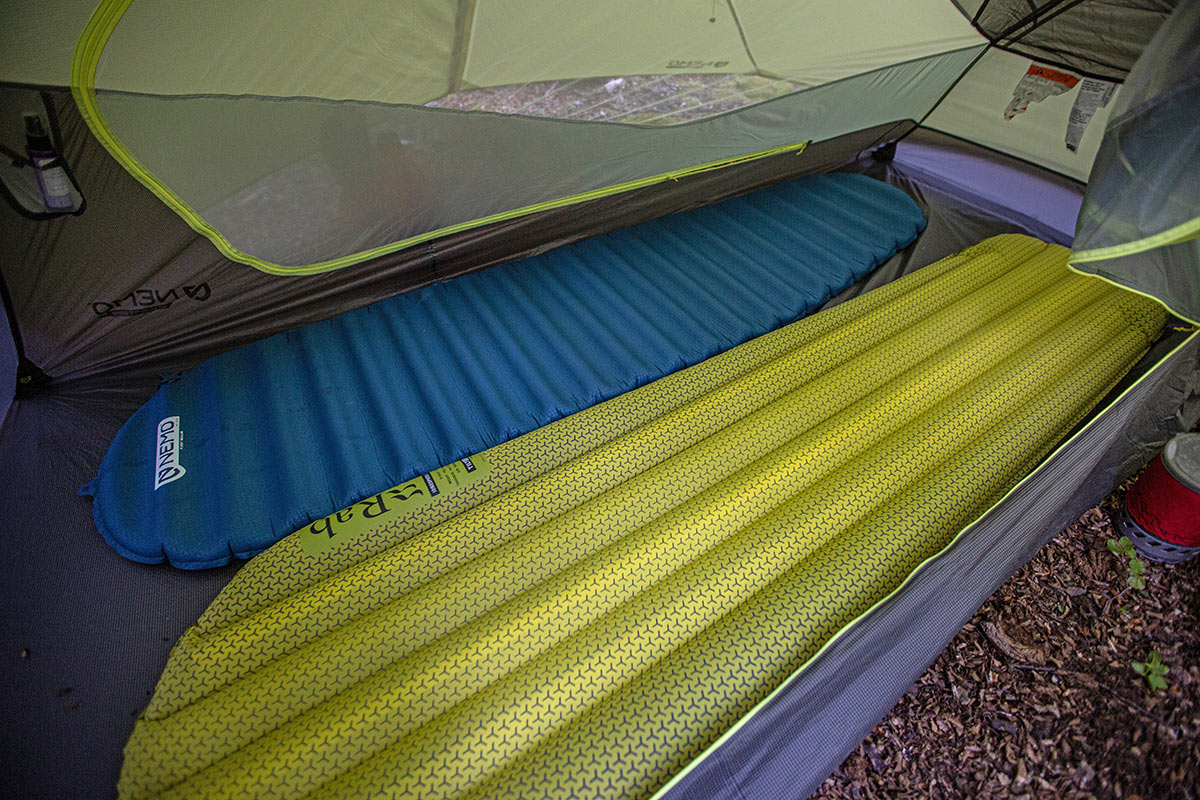
Tent volume, which accounts for the length, width, and angle of the walls, is the spec we really want, but few manufacturers actually provide it (SlingFin is one exception). Until this becomes commonplace, we recommend checking the floor area spec but also taking the time to analyze the tent shape—even just eyeballing it will help quite a bit, but we also advise digging into all of the dimensions (length, width, and peak height) to get a clearer picture. You can learn a lot from photos online. but, if possible, we recommend sitting inside the tent before you purchase to see how it feels in person. All that said, it's important to remember that a tent with more vertical walls will catch wind more aggressively. A benefit in one area usually means a tradeoff somewhere else, so it's all about considering the things that are most important to you personally.
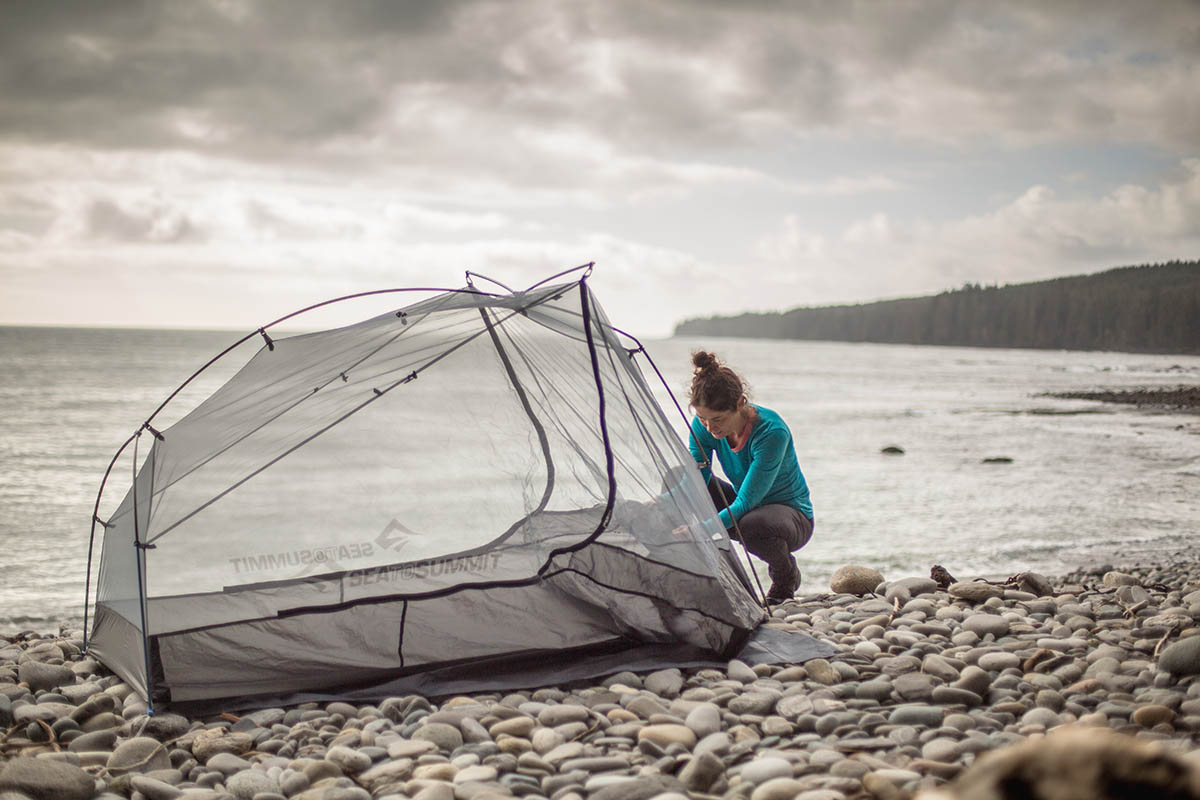
To achieve ridiculously low weights like the 1-pound-1.9-ounce Zpacks Duplex, manufacturers turn to a piece of gear a lot of backpackers already bring along: trekking poles. The main selling point of a trekking pole-supported shelter is that you don’t have to sacrifice interior volume or fabric durability in achieving really light weights. In fact, they’re competitive with and often beat standard tents that weigh twice as much in terms of floor area and tent volume. The biggest downside is added complexity during set-up—it can take some finessing to get a taut pitch, although we've found it gets considerably easier with practice. Some trekking-pole shelters do offer separate pole sets (the Zpacks Duplex is one) for versatility in pitch, though most ultralighters choose the trekking-pole setup to save weight.
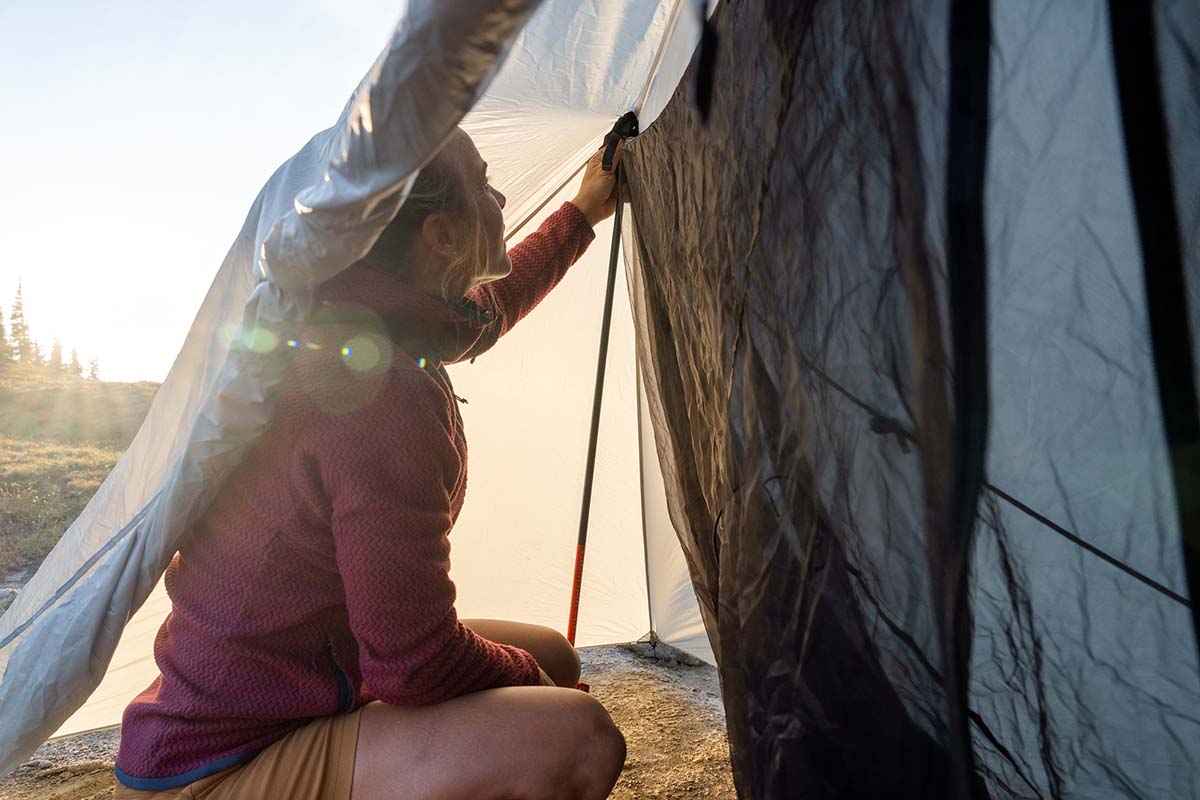
If you’d still like help narrowing down your selection, these are our team’s current favorite backpacking and ultralight tents broken down by category, from budget-friendly options for new backpackers to specialized, floorless shelters for ounce-counting minimalists. For a wider look at the market and detailed buying advice to help you get started, check our articles on the best backpacking tents and best ultralight tents.
Best Overall Backpacking Tent: Big Agnes Copper Spur UL2
Best Budget Backpacking Tent: REI Co-op Trail Hut 2
Best Combination of Price and Performance: REI Co-op Half Dome 2
Best Ultralight Backpacking Tent for Thru-Hiking: Zpacks Duplex Zip
Best All-Season Backpacking Tent: MSR Access 2
Best Overall Ultralight Backpacking Tent: Nemo Hornet Elite Osmo 2P
Best Budget Ultralight Backpacking Tent: Durston X-Mid 2
Best DCF Trekking-Pole Shelter for Thru-Hiking: Zpacks Duplex Zip
Best Ultralight 4-Season Tent: Samaya 2.0
Best Floorless Pyramid Shelter: Mountain Laurel Designs DuoMid
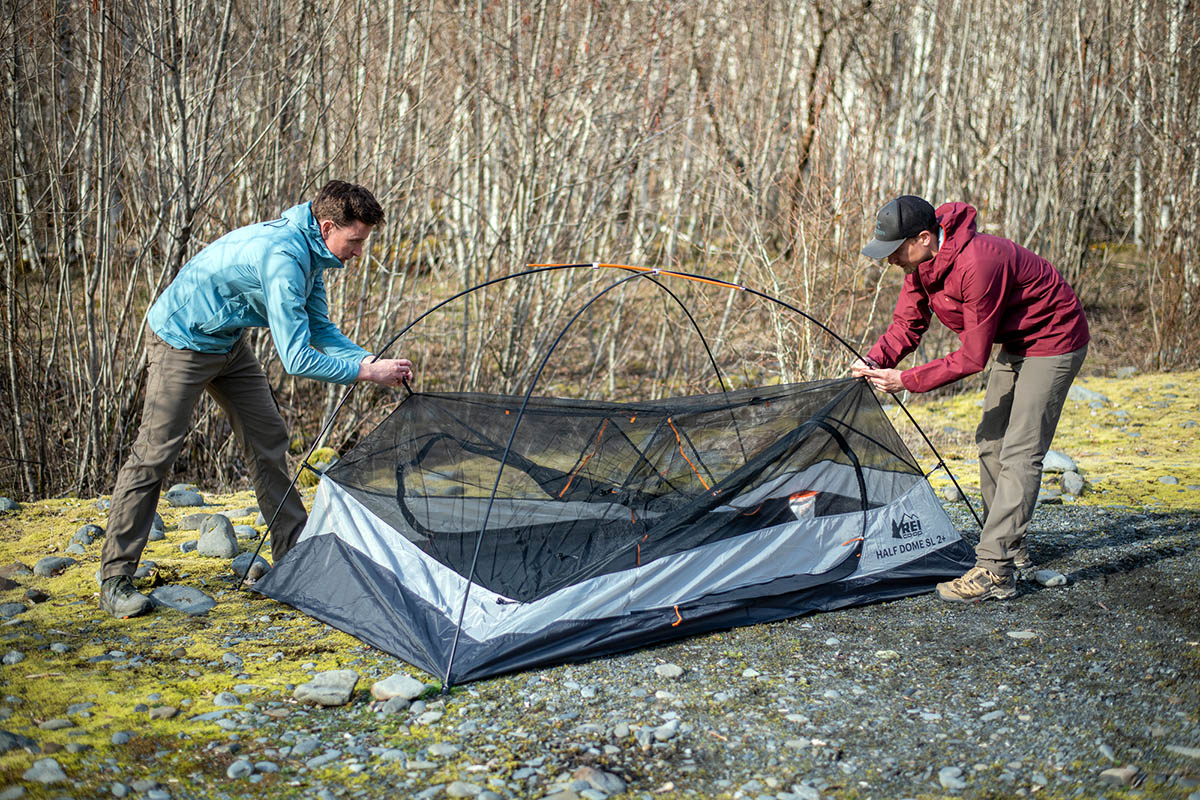
Tent weight is just one part of the larger weight equation, and there are numerous ways you can trim ounces from your pack. What’s commonly referred to as the sleep system (including both sleeping pad and sleeping bag) is another significant opportunity. To help with research, and because looking at the various designs is just plain fun, we’ve put together comprehensive charts comparing one-person tent and shelter weights and sleeping bag weights. As with tents, cutting weight often involves paying more and losing out on some durability, but your back, legs, knees, and ankles will surely thank you in the end.
Back to Backpacking Tents with Poles Back to Trekking Pole-Supported Shelters